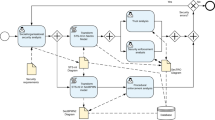Abstract
In this paper we focus on modeling concepts for safety-critical sociotechnical systems. First we claim that there is a great need for model-based reasoning about sociotechnical safety-critical requirements in system design and management. After this we take our starting point from formal methods, requirements engineering, and software architecture. We provide special extensions for these methods which are well-suited for the special challenges of sociotechnical systems: structural dynamism, uncertainty and the behavioral relevance of cognitive parameters. We maintain the visual style of modeling concepts as known from software architecture and provide an easy to use notation for reasoning about the features of specific decision situations. Finally we provide concepts to deal with adaptive system behavior and human error.
Access this chapter
Tax calculation will be finalised at checkout
Purchases are for personal use only
Preview
Unable to display preview. Download preview PDF.
Similar content being viewed by others
References
Baader, F., Calvanese, D., McGuiness, D., Nardi, D., Patel-Schneider, P.: The Description Logic Handbook. Theory, Implementation and Application. Cambridge Unversity Press, Cambridge (2003)
Harel, D.: Statecharts: a visual formalism for complex systems. Science of Computer Programming 8, 231–274 (1987)
Kacprzyk, J.: Multistage fuzzy control. Wiley, Chichester (1997)
Klir, G.J., Yuan, B.: Fuzzy Sets and Fuzzy Logic. Theory and Applications. Prentice Hall, Upper Saddle River (1995)
Leveson, N.: Safeware. System safety and computers. Addison Wesley, Reading (1995)
Lewis, D.: Convention: A Philosophical Study. Havard Univ. Pr., Cambridge (1969)
Mintzberg, H.: Structures in fives: designing effective organizations. Prentice Hall, Englewood Cliffs (1983)
Pepper, P., Cebulla, M., Didrich, K., Grieskamp, W.: From program languages to software languages. The Journal of Systems and Software 60 (2002)
Pepper, P., Frank, C., Holfelder, W., Jiang, D., Matylis, G.: Dynamic software architectures for a “sometimes somewhere” telematics concept. Technical report, Technische Universität Berlin (2003)
Pepper, P., Wirsing, M.: A method for the development of correct software. In: Jähnichen, S., Broy, M. (eds.) KORSO 1995. LNCS, vol. 1009, pp. 27–57. Springer, Heidelberg (1995)
Perrow, C.: Normal Accidents. Living with High-Risk Technologies. Basic Books, New York (1984)
Reason, J.: Human Error. Cambridge Univ. Pr., Cambridge (1990)
Shaw, M., Garlan, D.: Software Architecture. Perspectives on an emerging discipline. Prentice Hall, Upper Saddle River (1996)
Singh, M.P.: Multiagent Systems. A Theoretical Framework for Intentions, Know-how, and Communications. Springer, Heidelberg (1994)
Sperber, D., Wilson, D.: Relevance. Communication and cognition. Basil Blackwell, Oxford (1986)
Author information
Authors and Affiliations
Editor information
Editors and Affiliations
Rights and permissions
Copyright information
© 2004 Springer-Verlag Berlin Heidelberg
About this paper
Cite this paper
Cebulla, M. (2004). Modeling Concepts for Safety-Related Requirements in Sociotechnical Systems. In: Heisel, M., Liggesmeyer, P., Wittmann, S. (eds) Computer Safety, Reliability, and Security. SAFECOMP 2004. Lecture Notes in Computer Science, vol 3219. Springer, Berlin, Heidelberg. https://doi.org/10.1007/978-3-540-30138-7_8
Download citation
DOI: https://doi.org/10.1007/978-3-540-30138-7_8
Publisher Name: Springer, Berlin, Heidelberg
Print ISBN: 978-3-540-23176-9
Online ISBN: 978-3-540-30138-7
eBook Packages: Springer Book Archive




